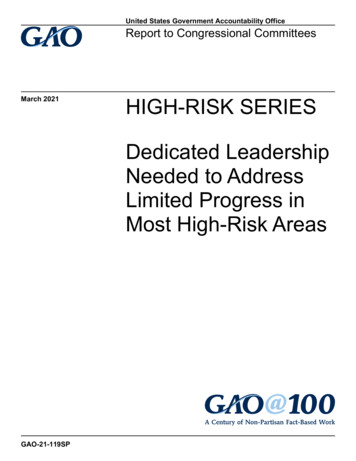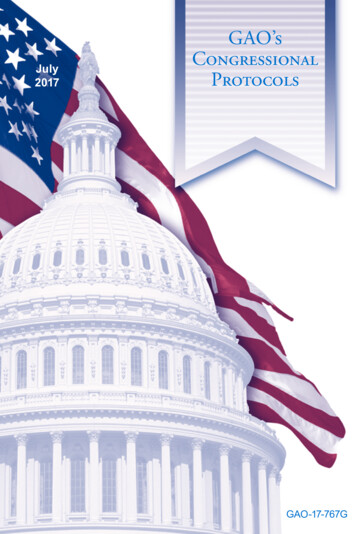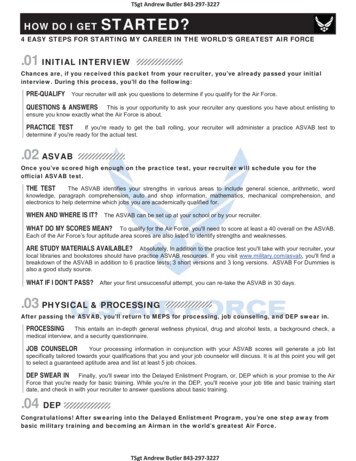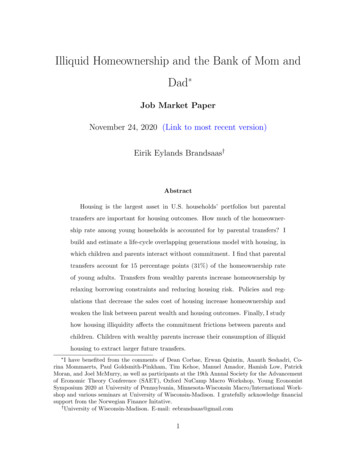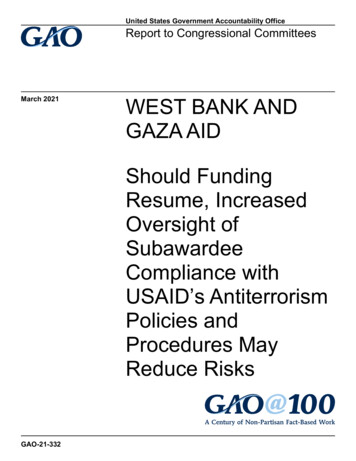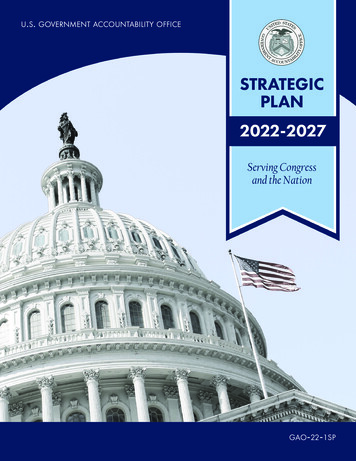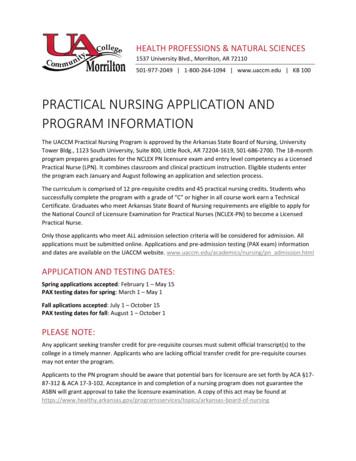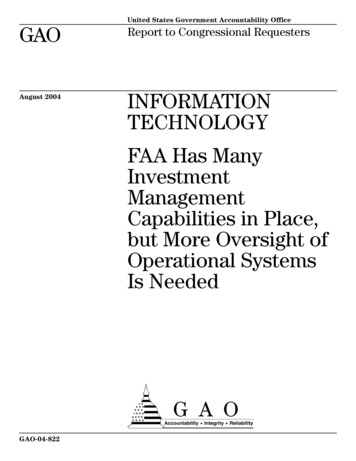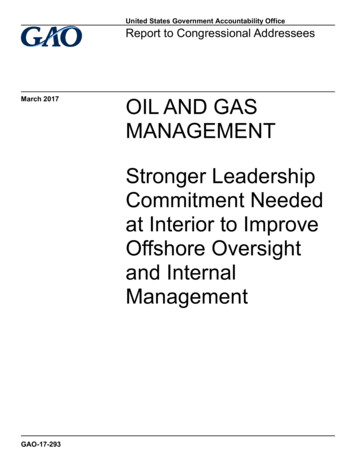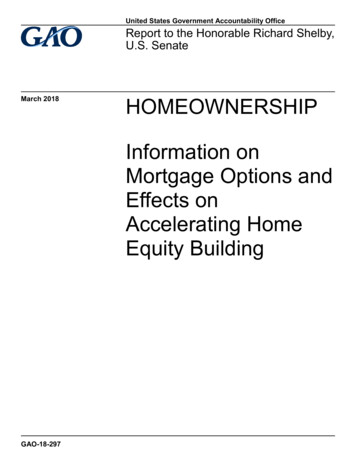
Transcription
United States Government Accountability OfficeReport to the Honorable Richard Shelby,U.S. SenateMarch 2018HOMEOWNERSHIPInformation onMortgage Options andEffects onAccelerating HomeEquity BuildingGAO-18-297
March 2018HOMEOWNERSHIPInformation on Mortgage Options and Effects onAccelerating Home Equity BuildingHighlights of GAO-18-297, a report to theHonorable Richard Shelby, U.S. SenateWhy GAO Did This StudyWhat GAO FoundThe federal government has a numberof programs to help increase access toaffordable homeownership for first-timebuyers and lower-income households,including programs that provideguarantees for certain types ofmortgages and funding that can beused for down-payment assistance.Generally, homeowners can buildhome equity by making payments on amortgage to reduce the outstandingprincipal (assuming home value doesnot depreciate). Recently, there hasbeen interest in mortgage products thataccelerate home equity building.Federal homeownership assistance programs generally are not designed toaccelerate equity building (home equity is the difference between the value of ahome and the amount owed on a mortgage). For example, programs that offergrants for down-payment assistance can provide a one-time boost to homeequity. However, these programs are not specifically designed to accelerateequity building—that is, increasing the pace of paying off principal more quicklythan would be the case with a 30-year fixed-rate mortgage. Instead, the focus offederal programs is on providing affordable access to homeownership, includingthrough grants, loans, and mortgage insurance or guarantees. For instance,federal mortgage insurance programs help provide market liquidity by protectinglenders from losses, in turn increasing access to credit and homeownership, andultimately, the opportunity for equity building for home buyers.GAO was asked to explore options forbuilding equity throughhomeownership. This report discusses(1) how federal homeownershipassistance programs affect homeequity building; and (2) options,including private-sector mortgageproducts, through which borrowers canaccelerate home equity building andthe trade-offs of these options for bothborrowers and lenders.GAO analyzed relevant laws andprogram guidance of federalhomeownership assistance programs.GAO attended housing conferencesand interviewed relevant federal andstate agency officials, academics, andindustry stakeholders, includingmortgage insurers and lenders, toidentify existing and proposedaccelerated equity-building productsand mechanisms and to betterunderstand the benefits and trade-offsof accelerated equity building. GAOalso developed examples of mortgagescenarios to illustrate the trade-offs ofaccelerated equity building. Federalagencies provided technicalcomments, which were incorporatedwhere appropriate.View GAO-18-297. For more information,contact Daniel Garcia-Diaz, 202-512-8678 orGarciaDiazD@gao.govBorrowers have options to accelerate equity building that include obtainingshorter-term mortgages, making more frequent or additional payments, orchoosing a mortgage product designed to accelerate equity building. Forexample, a mortgage product introduced by private lenders in 2014—the WealthBuilding Home Loan (WBHL)—has features designed to accelerate equitybuilding, including shorter terms (15 or 20 years) and the option to buy down theinterest rate. The product also allows for no down payment. However, theseproducts have trade-offs, including the following: Shorter-term loans build home equity (in terms of principal reduction) at afaster rate, but require higher monthly payments (see fig.). Payments for a15-year fixed-rate mortgage can be more than 40 percent higher than for a30-year fixed-rate mortgage. Higher payments may make mortgages less affordable or limit access forlower-income borrowers. For example, higher payments may result in ahigher debt-to-income ratio for some home buyers, which may prevent themfrom qualifying for a mortgage unless they buy a less expensive home. In contrast, all else equal, loans with a shorter term generally have reducedcredit risk—the likelihood of a home buyer defaulting on a mortgage—forlenders.Principal Reduction Pace: 15-Year Fixed-Rate Wealth Building Home Loan (WBHL) versus 30Year Fixed-Rate LoanNote: Monthly mortgage payments do not include property tax or any type of insurance. Interest ratesused are generally consistent with market rates in September and October 2017.United States Government Accountability Office
ContentsLetter1BackgroundFederal Homeownership Assistance Programs Can Have EquityBuilding Effects, but Are Not Specifically Designed toAccelerate Equity BuildingOptions and Mechanisms That Accelerate Equity Building PresentTrade-offs for Homeowners and LendersAgency Comments311Appendix IObjectives, Scope, and Methodology38Appendix IICoreLogic Home Equity Data, by State41Appendix IIIGAO Contact and Staff Acknowledgments431837TablesTable 1: Examples of Federal Homeownership AssistancePrograms and Effects on Equity BuildingTable 2: Examples of Mortgage Loan and Refinancing Fees andCost EstimatesTable 3: Examples of Different Mortgages’ Effects on Debt-toIncome RatioTable 4: Example of Different Mortgage Type’s Effect onPurchasing Power12203133FiguresFigure 1: Example of the Allocation of Monthly Mortgage Paymentto Interest and Principal, for a Selected 30-Year FixedRate MortgageFigure 2: Example of Home Equity Built over Time for a 225,000,30-year Fixed-Rate Mortgage: Required Payment versusAdditional 100 Payment Each MonthFigure 3: Examples of the Effects of Select Refinancing Scenarioson Home EquityPage i61921GAO-18-297 Homeownership
Figure 4: Comparison of Home Equity Built over Time: 15-yearWealth Building Home Loan (WBHL) versus 15- and 30Year Fixed-Rate MortgagesFigure 5: Overview of Monthly Payment Scenarios for FixedPayment Cost-of-Funds Index (Fixed-COFI) MortgageFigure 6: Example of Loan-to-Value (LTV) Ratio over 5.5 years,15-Year Fixed-Rate Mortgage (103 Percent LTV Ratio atOrigination), and 30-year Fixed-Rate Mortgage (80Percent LTV Ratio at Origination)Figure 7: Total Interest Paid on a 250,000 Mortgage underDifferent ScenariosFigure 8: Percentage of Residents with Less Than 20 Percent inHome Equity, by State, as of First Quarter 2017Page ii2326282942GAO-18-297 Homeownership
Abbreviations ListAHPARMCDBGDodd-FrankenterprisesFederal BHLAffordable Housing Programadjustable-rate mortgageCommunity Development Block GrantDodd-Frank Wall Street Reform and ConsumerProtection ActFannie Mae and Freddie MacBoard of Governors of the Federal ReserveFederal Housing AdministrationFederal Housing Finance AgencyFederal Home Loan BanksFixed-Payment Cost-of-Funds IndexDepartment of Housing and Urban Developmentloan-to-valuequalified mortgage loansRural Housing ServiceDepartment of AgricultureDepartment of Veterans AffairsWealth Building Home LoanThis is a work of the U.S. government and is not subject to copyright protection in theUnited States. The published product may be reproduced and distributed in its entiretywithout further permission from GAO. However, because this work may containcopyrighted images or other material, permission from the copyright holder may benecessary if you wish to reproduce this material separately.Page iiiGAO-18-297 Homeownership
Letter441 G St. N.W.Washington, DC 20548March 15, 2018The Honorable Richard ShelbyUnited States SenateDear Senator Shelby:The federal government has a number of programs to help increaseaccess to affordable homeownership for first-time buyers and lowerincome households, including programs that provide guarantees forcertain types of mortgages and funding that can be used for downpayment assistance. 1 Homeownership has long been perceived toprovide a number of financial and nonfinancial benefits. For example,homeownership can build wealth through the accumulation andappreciation of home equity—the difference between the value of a homeand the amount owed on the mortgage. 2 Home equity can serve as afinancial cushion in times of hardship or financial emergencies, especiallyamong lower-income households for whom housing generally constitutesa larger percentage of assets than for higher-income households. 3According to the U.S. Census Bureau, the homeownership rate wasabout 64 percent at the end of the third quarter 2017, and according tothe Board of Governors of the Federal Reserve (Federal Reserve), thetotal outstanding mortgage debt in the same period was 10.5 trillion. Inaddition, more than 21 percent of homeowners had less than 20 percentequity in their homes (see app. II for more information). According to ouranalysis, for a borrower who bought a home with a 30-year fixed-ratemortgage and a small down payment, it could take more than 8 years inthe current interest rate environment to achieve 20 percent equity in thehome (assuming the home’s value remained unchanged from loan1We use “lower-income” to refer to households for which federal homeownershipassistance programs are generally targeted, though many programs have specific incomeeligibility requirements.2Although there are many ways to build equity and wealth—including saving and investingin other types of financial assets—this report will focus on building equity throughhomeownership.3Board of Governors of the Federal Reserve System, Survey of Consumer Finances(Washington, D.C.: 2016).Page 1GAO-18-297 Homeownership
origination). 4 Homeownership can build wealth, but it also entails risks(such as depreciating home values) and costs (such as for maintenance,taxes, and insurance). Recently there has been some interest inmortgage products designed to accelerate equity building—that is,products that increase the ongoing pace of paying off the loan principalcompared to a traditional 30-year fixed-rate mortgage—and improveaccess to homeownership. 5You asked us to explore options for building equity throughhomeownership. 6 This report describes (1) how federal homeownershipassistance programs affect home equity building, and (2) options,including private-sector mortgage products, through which borrowers canaccelerate home equity building and the trade-offs of these options forboth borrowers and lenders. You also asked us to include regional dataon equity building, which is included in an appendix to this report.To address these objectives, we reviewed relevant literature, includingprior GAO reports on housing assistance and homeownership, housingfinance, and mortgage reforms. 7 We interviewed officials with knowledgeof federal homeownership assistance programs from the Department ofHousing and Urban Development (HUD), Federal Housing FinanceAgency (FHFA), Department of Agriculture (USDA), Department ofVeterans Affairs (VA), Fannie Mae, Freddie Mac, Federal Home LoanBanks (FHLBanks), and state housing finance agencies. We attendedhousing conferences and met with housing experts and stakeholders fromacademia, housing advocacy organizations, and industry, includingmortgage lenders and insurers, selected because they made proposals toincrease homeownership or build home equity faster, wrote on4For this scenario, we assumed that a homeowner purchased a 250,000 home with 3percent down and that the interest rate on the loan was 3.875 percent.5For purposes of our report, we are defining accelerated equity building as increasing theongoing pace of paying down principal, and not just a one-time extra payment towardsprincipal.6This review was conducted in response to a 2016 request from Senator RichardShelby—then Chairman, Senate Committee on Banking, Housing, and Urban Affairs.7For example, see GAO, Housing Assistance: Opportunities Exist to IncreaseCollaboration and Consider Consolidation, GAO-12-554 (Washington, D.C.: Aug. 16,2012); Housing Finance System: A Framework for Assessing Potential Changes,GAO-15-131 (Washington, D.C.: Oct. 7, 2014); and Mortgage Reforms: Actions Needed toHelp Assess Effects of New Regulations, GAO-15-185 (Washington, D.C.: June 25,2015).Page 2GAO-18-297 Homeownership
homeownership issues, were recommended by government officials, orwere involved in providing mortgage products designed to accelerateequity building. From interviews with industry stakeholders and housingconferences we attended, we were able to identify and review informationon two private-sector mortgage products—one existing and oneproposed—designed to accelerate home equity building. We usedexamples from those products to illustrate effects and trade-offs on homeequity of select scenarios. See appendix I for more information on ourscope and methodology.We conducted this performance audit from January 2017 to March 2018in accordance with generally accepted government auditing standards.Those standards require that we plan and perform the audit to obtainsufficient, appropriate evidence to provide a reasonable basis for ourfindings and conclusions based on our audit objectives. We believe thatthe evidence obtained provides a reasonable basis for our findings andconclusions based on our audit objectives.BackgroundHome Equity BuildingA homeowner can build home equity immediately by making a downpayment on their home, assuming the down payment is not financedseparately as a loan. 8 Throughout the life of a mortgage, homeownerscan continue to build equity (1) by making regular mortgage payments toreduce the principal amount outstanding, (2) by making additionalpayments to further reduce the principal amount outstanding, and (3)through appreciation in their home’s value. Additionally, the componentsof a mortgage (discussed below) may affect the pace of home equitybuilding.Throughout this report, for the purposes of illustrating home equitybuilding, we assumed that a home’s value remained unchanged from thetime of the loan origination. However, home values are highly contingenton market conditions and other factors that are beyond a homeowner’scontrol. For example, although homes can appreciate in value, homesalso can depreciate in value, which can have a negative effect on8This assumes the homeowner purchased the home at or below the appraised marketvalue. If a homeowner paid more than the appraised market value, the homeowner mighthave negative equity in the home.Page 3GAO-18-297 Homeownership
homeowners’ equity. Homeowners also could lose money on their home ifthey sold it shortly after purchasing because principal reduction in theinitial years of a mortgage is relatively small and the benefit of any homevalue appreciation would be limited. Additionally, selling a home incurstransaction costs, such as realtor commissions. To avoid losing money ona home sale, homeowners would need to sell their home at an amounthigher than their purchase price plus transactions costs. For example, if ahomeowner buys a home for 250,000 (all fees included) and plans tosell it 3 years later, assuming transaction costs of 10 percent (or 25,000), the homeowner would have to sell the home for at least 275,000 to break even, meaning an annual appreciation in home valueof more than 3 percent. If the home’s value did not appreciate at that rate,or depreciated, the homeowner would lose money on the sale.Mortgage LoanComponentsThe majority of American families achieve homeownership by taking out aloan—a mortgage—to cover at least some of the purchase price. 9 Theprimary components of a mortgage loan are the following: Term (duration). The most common term is 30 years. According tothe Urban Institute, the 30-year fixed-rate mortgage representedapproximately 90 percent of the fixed-rate purchase mortgages (thatis, not for refinancing an existing mortgage) originated every monthfrom January 2010 through July 2017, and 15-year fixed-ratepurchase mortgages represented about 6 percent. 10 Down payment. Most mortgage lenders require borrowers to make adown payment (of 3 percent or more of the purchase price, dependingon the mortgage) that is applied to the purchase price of the home. Adown payment also helps a borrower build home equity, assuming thedown payment is not financed as a separate loan. Interest rate. Lenders charge borrowers a percentage of themortgage amount, in exchange for providing funds to buy a home. Aninterest rate can be fixed or adjustable for the life of the mortgage9For purposes of this report, a mortgage or mortgage loan refers to both a promissorynote and a security interest. A promissory note evidences the debt and a borrower’sagreement to make principal and interest payments to the lender for a period of time. Tosecure the debt, lenders obtain a lien or security interest in the underlying property ascollateral against borrower default.10The 15-year fixed-rate mortgage is more commonly used for refinancing. Urban Institute,Housing Finance at a Glance: A Monthly Chartbook (Washington, D.C.: October 2017).Page 4GAO-18-297 Homeownership
(adjustable-rate mortgage or ARM). Because a fixed-rate mortgage’sinterest rate does not change regardless of prevailing rates, aborrower’s payments for principal and interest remain the same for thelife of the mortgage. In contrast, an adjustable-rate mortgage’sinterest rate, for which the initial interest is generally lower than for afixed-rate mortgage, will adjust at agreed-upon intervals. 11 As a result,adjustable-rate mortgage payments can increase or decreasedepending on the changes in interest rates and terms of the loan. Payment frequency and amount. Payments are generally made ona monthly basis. Fixed- and adjustable-rate mortgages generally havefully amortizing payment schedules—that is, the regularly scheduledpayments will fully pay down the principal and interest over the life ofthe mortgage, with the amounts allocated to reducing principal andinterest changing over time (see fig. 1).11Adjustments generally are based on a specific index rate, and the adjusted rate will fallwithin an agreed maximum and minimum range.Page 5GAO-18-297 Homeownership
Figure 1: Example of the Allocation of Monthly Mortgage Payment to Interest and Principal, for a Selected 30-Year Fixed-RateMortgageNote: This scenario is based on an amortized monthly payment for a 225,000, 30-year mortgagewith a fixed annual interest rate of 3.875 percent. The monthly payment amount does not includetaxes, insurance, or any condominium or association fees.Page 6GAO-18-297 Homeownership
The Federal Role inMortgage MarketsThe U.S. markets for single-family housing finance include a primarymarket, in which lenders make (originate) or refinance mortgage loans,and a secondary market, in which mortgage loans are purchased fromlenders and packaged into securities—known as mortgage-backedsecurities—that are sold to investors. 12 The federal governmentparticipates in the primary and secondary mortgage markets.In the primary market, federal agencies provide homeownershipassistance programs and products intended for increasing access to andaffordability of homeownership. Relevant federal agencies and agovernment-sponsored enterprise that provide homeownershipassistance and their primary housing-related policy goals include thefollowing: Department of Housing and Urban Development provides housingassistance to low-and moderate-income families and promotes urbandevelopment. Federal Housing Administration (FHA) seeks to broadenhomeownership, strengthen the mortgage marketplace, andincrease access to credit by providing mortgage insurance. Public and Indian Housing helps ensure safe, decent, andaffordable housing through programs such as housing choicevouchers. Community Planning and Development seeks to develop viablecommunities and provide decent housing and a suitable livingenvironment through block grant assistance. Department of Veterans Affairs assists service members, veterans,and eligible surviving spouses of veterans to become homeownersthrough guaranteeing and issuing (in limited circumstances)mortgages for home purchases. Rural Housing Service (RHS), which is an agency within USDA,insures and guarantees housing loans for home purchases, repair,and rental housing development.12In the secondary market, institutions purchase loans from primary market mortgageoriginators and then hold the loans in portfolio or bundle the loans into mortgage-backedsecurities that are sold to investors. According to FHFA officials, mortgage products,including mortgage-backed securities, must have features attractive to investors forsecuritizing and trading in the secondary market. For example, products must be scalablein terms of volume, uniformity, and performance data.Page 7GAO-18-297 Homeownership
Federal Home Loan Banks help provide liquidity to each bank’smember financial institutions to support housing finance andcommunity investment. FHLBank members include commercialbanks, thrifts, and credit unions. FHLBanks provide 10 percent of theirearnings for affordable housing programs, including grants foraffordable housing for households with incomes at or below 80percent of the area median.Federal homeownership assistance programs can be categorized interms of the products or services they offer or the mechanisms they use.The categories include mortgage guarantees and insurance, downpayment assistance, vouchers, and direct loans (discussed in more detaillater in this report). In addition to these categories of homeownershipassistance, tax expenditures, such as exclusions, exemptions, deductions(including the mortgage interest deduction), credits, deferrals, andpreferential rates, can promote homeownership. For example,homeowners can take advantage of tax deductions (by choosing toitemize deductions on their tax returns) to help lower their taxable income.Taxpayers who itemize deductions may deduct qualified interest they payon their mortgage. Taxable income may be reduced by the amount ofinterest paid on first and second mortgages of up to 750,000 for homespurchased generally after December 15, 2017. 13 Additionally, taxpayersgenerally may deduct up to 10,000 for state and local taxes, includingproperty taxes paid by homeowners on their homes. 14Participation in the secondary mortgage market occurs through thefollowing entities: Fannie Mae and Freddie Mac. Fannie Mae and Freddie Mac aregovernment-sponsored enterprises (enterprises)—congressionallychartered, for-profit, shareholder-owned companies. They are the two13For homes purchased on or before December 15, 2017, taxpayers can deduct intereston the total mortgage, generally for debt up to 1 million. Prior to 2018, homeownersgenerally could also deduct interest payments on up to 100,000 of home equity debt. For2017, the mortgage interest deduction cost an estimated 64 billion in forgone income taxrevenue, according to the Joint Committee on Taxation. For taxable years beginning afterDecember 31, 2025, taxpayers may deduct interest on up to 1 million, regardless ofwhen the indebtedness is incurred.14Prior to 2018, there were no dollar limits on the amounts of property taxes thathomeowners could deduct. The new limitation is applicable to tax years beginning afterDecember 31, 2017, and before January 1, 2026. For 2017, the deduction of propertytaxes for owner-occupied homes cost an estimated 33.3 billion in forgone income taxrevenue, according to the Joint Committee on Taxation.Page 8GAO-18-297 Homeownership
largest participants operating in the secondary mortgage market. 15Generally, Fannie Mae and Freddie Mac purchase mortgage loansthat meet certain criteria for size, features, and underwritingstandards—known as conforming loans—from lenders. 16 Inpurchasing loans, the enterprises provide market liquidity, so lenderscan provide more loans to borrowers. Mortgage-RelatedRegulationsGinnie Mae. Ginnie Mae is a wholly-owned government corporation.Ginnie Mae guarantees the timely payment of principal and interest onmortgage-backed securities supported by pools of loans backed bygovernment-insured mortgages, including mortgages insured by FHA,VA, and USDA.In a process called underwriting, mortgage lenders evaluate thecreditworthiness of potential borrowers in making mortgage loans, amongother things. Amid concerns that risky mortgage products and poorunderwriting standards contributed to the recent housing crisis, Congressincluded mortgage reform provisions in the Dodd-Frank Wall StreetReform and Consumer Protection Act (Dodd-Frank Act). The Dodd-FrankAct generally requires lenders to determine consumers’ ability to repayhome mortgage loans before extending credit and provides apresumption of compliance with the ability-to-repay requirement forqualified mortgages.The ability-to-repay regulations set forth lenders’ responsibilities todetermine a borrower’s ability to repay a residential mortgage loan, andspecial payment calculation rules apply for loans with balloon payments,15The FHFA is an independent agency responsible for oversight of Fannie Mae, FreddieMac, and the FHLBanks. FHFA has a statutory responsibility to ensure that these entitiesoperate in a safe and sound manner and that their operations and activities foster liquid,efficient, competitive, and resilient national housing finance markets. On September 6,2008, FHFA placed Fannie and Freddie into conservatorship, due to a substantialdeterioration in their financial condition.16The conforming loan limit for single-family homes in 2018 is 453,100 ( 679,650 in highcost areas) in the contiguous United States, District of Columbia, and Puerto Rico. Inareas outside of the contiguous states, the limit is 679,650 ( 1,019,476 in high-costareas). Mortgages that are larger than the conforming loan limit are known as “jumboloans.”Page 9GAO-18-297 Homeownership
interest only payments, or negative amortization. 17 The regulationsrequire lenders to make a reasonable and good faith determination of aconsumer’s reasonable ability to repay a loan. The regulations establish asafe harbor and a presumption of compliance with the ability-to-repay rulefor certain qualified mortgage loans (QM). The rule generally prohibitsloans with negative amortization, interest-only payments, or balloonpayments from being qualified mortgages, and limits the points and fees alender may charge borrowers on a qualified loan. 18 The regulationsestablish general underwriting criteria for qualified mortgages. Forexample, under QM requirements borrowers generally cannot exceed amaximum monthly debt-to-income ratio of 43 percent, unless the loan iseligible for sale to an enterprise. 19 If a mortgage loan meets therequirements of a QM loan, it is eligible for the safe harbor and the lenderis deemed to have complied with the ability-to-pay requirement unless theloan is a higher priced mortgage loan. A higher priced mortgage loan thatotherwise meets the definition of a QM is presumed to have complied withthe ability-to-pay requirements, but the presumption can be rebutted if theconsumer proves that the lender did not make a good faith andreasonable determination of the consumer’s ability to repay. 2017When making the ability-to-pay determination, lenders generally must consider at leasteight underwriting factors: (1) current or reasonably expected income or assets; (2)current employment status; (3) the monthly payment on the covered transaction (themonthly payment must be calculated based on any introductory rate or fully indexed ratefor the loan, whichever is higher, and substantially equal, fully amortizing monthlypayments); (4) the monthly payment on any simultaneous loan; (5) the monthly paymentfor mortgage-related obligations; (6) current debt obligations, alimony, and child support;(7) the monthly debt-to-income ratio or residual income; and (8) credit history.18A point is equal to 1 percent of the amount of a loan.19The rule provides for a temporary category of qualified mortgages that have a moreflexible underwriting requirement if they meet the general product feature prerequisites fora qualified mortgage and are eligible to be purchased by the enterprises. The monthlydebt-to-income ratio represents the percentage of a borrower’s total monthly income thatgoes toward total monthly debt obligations, including the mortgage payments,simultaneous loans, mortgage-related obligations, current debt obligations, alimony, andchild support. A higher ratio is generally associated with a higher risk that the borrower willhave cash flow problems and may miss mortgage payments.20In general, a higher-priced mortgage has an annual rate exceeding the prime offer rateby 1.5 percentage points or more for a first-lien transaction.Page 10GAO-18-297 Homeownership
Additionally, federal mortgage insurance is included in the determinationof whether an FHA-insured loan is a higher priced mortgage loan. 21FederalHomeownershipAssistance ProgramsCan Have EquityBuilding Effects, butAre Not SpecificallyDesigned toAccelerate EquityBuildingExisting federal homeownership assistance programs use features andmechanisms that can have equity-building effects, but the programs arenot specifically designed to accelerate equity building. The programs canassist homeowners to build equity over time by providing access tohomeownership, but the programs do not have an explicit focus onaccelerating the ongoing pace of paying down the loan principal fasterthan a 30-year fixed-rate mortgage. Rather, the overall focus of theprograms is on providing affordable access to homeownership, accordingto officials of relevant agencies and entities and based on their missiongoals. For example, the goal of FHA’s mortgage insurance program is tofacilitate access to affordable mortgages for home buyers who might notbe well-served by the private market. FHA implements this goal byproviding insurance to lenders to facilitate access to mortgage financingfor lower-income home buyers.See table 1 for examples of federal homeownership assistance programs,by major program types and potential for affecting equity building
through grants, loans, and mortgage insurance or guarantees. For instance, federal mortgage insurance programs help provide market liquidity by protecting lenders from losses, in turn increasing access to credit and homeownership, and ultimately, the opportunity for equity building for home buyers.
